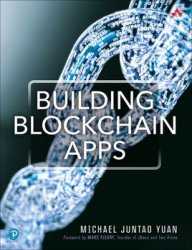 Название: Building Blockchain Apps (Final)
Название: Building Blockchain Apps (Final) Автор: Michael Juntao Yuan
Издательство: Addison-Wesley Professional
Год: 2020
Страниц: 336
Язык: английский
Формат: pdf (true), epub
Размер: 10.2 MB, 28.6 MB
A Developer's Guide to Blockchain Programming Fundamentals.
The easiest way to get started with blockchain application development is to use the open source BUIDL tool - an online integrated development environment (IDE) that works in any modern web browser. BUIDL provides a comprehensive coding environment for creating and deploying end-to-end blockchain applications. You can create an entire blockchain application inside BUIDL, from smart contracts on the back end to HTML on the front end, and everything in the middle.
Blockchain development is entering a period of explosive growth, as real applications gain traction throughout multiple industries and cryptocurrencies earn greater acceptance throughout the financial sector. Blockchain represents one of the most promising opportunities for developers to advance and succeed. Building Blockchain Apps is an accessible guide to today’s most advanced and robust blockchain programming models and architectures.
Building on his pioneering experience, Michael Juntao Yuan covers a wide range of blockchain application development paradigms. The book starts with a concise introduction to blockchain and smart contract technologies. It then guides you through application development on Ethereum-compatible smart contract platforms. Ethereum is the largest and most robust blockchain ecosystem in the world.
In first part of the book, Michael introduce the basic concepts of blockchain technology, such as trustless consensus, cryptocurrencies, and cryptoeconomics. For application developers and business executives, it is crucial to understand these concepts, as they establish a common vocabulary for further discussion. It is necessary for you to learn the essential features and key characteristics of blockchain networks in order to design and develop blockchain applications.
The central idea behind blockchain networks is not really the technology - hash algorithms and public key infrastructure (PKI) technologies have existed for many years. The chief innovation in Bitcoin is a new incentive structure to make sure that although every individual in the network is uncooperative (i.e., decentralized), they will nevertheless collectively behave in a way that maintains the integrity and security of the network. Economic incentives from cryptocurrencies are working in tandem with technological solutions in blockchain networks to solve problems that were previously impossible to address with technology alone. The most important example of this seamless collaboration between software engineering and economic design is the blockchain’s consensus mechanism.
Coverage includes:
Ethereum topics such as tools, application frameworks, internal data structures, external data interfaces, and future roadmap
An introduction to new blockchain data protocol based on ElasticSearch, which provides insights into the current state of smart contracts and enables new application designs
How to build an application-specific smart contract protocol by modifying and customizing the open source Ethereum Virtual Machine and its programming language tools
How to extend and support language features that are most suitable for particular kinds of smart contracts (e.g., smart contracts for e-commerce marketplaces) with the open source Lity project
How to customize and change the blockchain consensus layer beneath the application layer via the popular Tendermint and Cosmos SDK frameworks
A survey of cryptocurrency and financial topics from the developers’ point of view, providing an analytical framework for valuating cryptocurrencies and explaining the roles of crypto exchanges
Скачать Building Blockchain Apps (Final)
True PDF:
ePub: